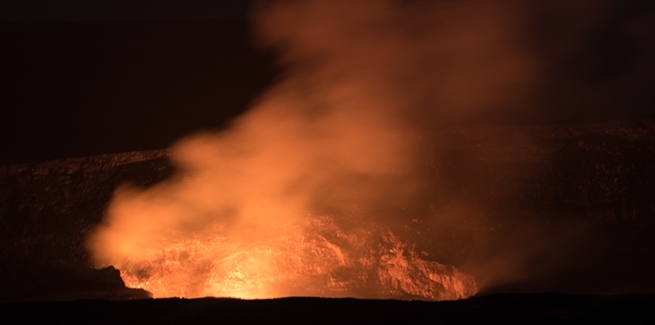Veterinarians versus the volcano

As the world’s most active volcano, Kilauea has been erupting almost constantly since 1983.
One of five volcanoes that form the actual island of Hawaii, commonly known as the Big Island, it’s been a lot more active since May third, when the first of 18 new fissures opened up, spewing lava hundreds of feet in the air. Since then, a continuous flow of lava has swallowed cars, destroyed at least 25 homes, and forced the evacuation of nearly 2,000 residents.
The State of Hawaii has 13 AAHA-accredited animal hospitals, but only two of them call the Big Island home. And fortunately, both are on the far side of the island (away from Kilauea).
NEWStat checked in to see how they’re doing.
Jolene Head, co-owner and practice manager of AAHA-accredited Keauhou Veterinary Hospital in Kailua-Kona, says the volcano hasn’t affected them too much. “We're about a hundred miles away,” she says. “The Big Island is so big, you can fit all the other islands in it,” she adds, to give some sense of scale. Then she laughs. “It’s a big island.”
But while the practice itself isn’t directly in harm’s way, Head and her staff have been keeping a close eye on the volcano’s activity.
“Mostly what we’ve been experiencing on this side of the island right now is volcanic debris that’s in the air,” Head says. “It makes your eyes itchy and makes your throat dry. It makes you feel a little bit fatigued.” She says the debris, known colloquially as vog (as in volcanic fog) is affecting the staff’s pets, as well. “They seem to be kind of rubbing their eyes. [But] we haven’t really seen any impact in terms of injury or illness in direct relation to that.”
“We have a lot of clients down that direction who have had to evacuate or be relocated, and if they have cats, we’ve offered to board them if needed,” she says. Luckily, no one’s had to take the hospital up on its offer yet. “For the most part, most of those people are either sheltering in place or have been evacuated from those areas.”
Bob Jordan, DVM, co-owner of AAHA-accredited Kona Veterinary Service in Kailua-Kona, echoes Head’s assessment of the volcano’s impact. “For day-to-day activity, it really hasn’t done anything. We’ve seen no ill effects.”
Jordan says he has seen an uptick in at least one volcano-related area of Kona’s business, due in part to their location. “Our hospital is relatively close to the airport. We’ve seen a lot of clients with pets coming in for health certificates.” Jordan says that by law, all pets need to be examined by a veterinarian and issued certificates attesting that they’re healthy when arriving on or leaving the island. “We’ve seen a noticeable increase.”
Like Head, Jordan says the vog is their biggest volcano-related problem.
“It’s toxic gas,” he says. “There’s sulfur dioxide in it. It shifts with the wind. That’s been an ongoing thing. It will come to our side of the island depending on the wind flow.”
NEWStat also checked in with a non-accredited hospital closer to the action.
At the Aloha Veterinary Center in Hilo, directly across the Big Island from Kailua-Kona, owner Trevor Rodrigues, DVM, says his hospital is about 45 minutes away from the volcano, so they’re a little busier. “We’re seeing a few dogs with smoke inhalation,” says Rodrigues. “We’ve seen dogs showing stress from all the trauma.”
Mostly, that was the trauma of being left behind.
During the first couple of days after the eruption, Rodrigues says people forced to evacuate couldn’t always take their pets. “So there were pets left in the yard. The people couldn’t go back for four days. The dogs were really traumatized.” Cats were traumatized, too, he added, noting, “the cats, of course, could run away.”
Rodrigues says most of the runaway cats have been found and reunited with their owners. “The Humane Society is doing a terrific job over here as far as going out and recovering cats.”
Most of the volcano-related action Aloha has seen, trauma and smoke inhalation aside, involves boarding pets. The hospital is boarding half a dozen for owners who’ve been evacuated but don’t know when or if they’ll be able to go home. “They don’t know what’s going to happen to their houses,” Rodrigues says.
That includes one member of the Aloha hospital staff who was evacuated. Rodrigues says the hospital will board her pet until it’s safe for both to return home.
All in all, it’s been an exciting couple of weeks on the Big Island. And we haven’t even mentioned the earthquakes, yet.
“Here in Kona, we've definitely felt the earthquakes,” Says Keauhou’s Head. She says they’ve had more than 1,200 in the past two weeks.
But she’s not too worried.
“For the most part, we’re safe, we’re okay, we just really feel bad for all those people down [near the volcano] who are not. This is something that’s going to be very impactful for that area for a very long time.”
But she’s also philosophical about their situation.
“The reality of it is, we live on an active volcano, and this is what that life looks like.”
Photo credit: © Daniel Van Pelt



